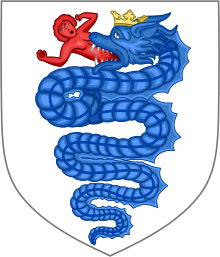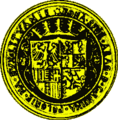Biscione
This article needs additional citations for verification. (September 2016) |

The biscione[a] (English: "big grass snake"), less commonly known also as the vipera,[b] is in heraldry a charge consisting of a divine serpent in the act of giving birth to a child. It is a historic symbol of the city of Milan, used by companies based in the city.
History
[edit]Etymologically, word biscione is a masculine augmentative of Italian feminine biscia "grass snake" (corrupted from bistia, ultimately from Latin bestia "beast").
The charge became associated with the city after the Visconti family gained control over Milan 1277; Bonvesin da la Riva records it in his De magnalibus urbis Mediolani (On the Marvels of the City of Milan) as a Visconti symbol no later than the end of the 13th century.[1] The symbol may have been derived from a bronzed serpent brought to Milan from Constantinople by Arnolf II of Arsago (Archbishop of Milan 998–1018) in the 11th century.[2]

One of the oldest depictions of the Biscione is in the Great Hall of the Visconti Castle of Angera. The hall was painted at the end of the 13th century with frescoes celebrating Archbishop Ottone Visconti's victory against the rival family of the Della Torre. The viper swallowing a small human figure is depicted in the pendentives of the hall.[3]

The biscione remained associated with the Duchy of Milan even after the Visconti line died out in the 15th century.[4] The House of Sforza incorporated the symbol into their armorial after taking the duchy.
A Renaissance Milanese writer described the insignia of the Duke of Milan in 1531:
Latin: Exiliens infans sinuosi e faucibus anguis, Est gentilitiis nobile stemma tuis. Talia Pellaeum gesisse nomismata regem, Vidimus, hisque suum concelebrare genus. Dum se Ammone satum, matrem anguis imagine lusam, Divini & sobolem seminis esse docet. Ore exit tradunt sic quosdam enitier angues, An quia sic Pallas de capite orta Iovis.
English: An infant bursting from the maw of a coiling serpent marks the noble lineage of your clan. We have observed that the Pellaean king had coinage with such a device and by it celebrated his own descent, proclaiming that he was begotten of Ammon, that his mother was beguiled by the form of a snake and the child was the offspring of divine seed. The infant emerges from the mouth. They say that some snakes come to birth that way. Or is it because Pallas sprang like this from the head of Jove?
Contemporary use
[edit]As a symbol of Milan, the biscione is used by multiple organizations associated with or based in the city. Football club Inter Milan is commonly represented by a biscione, and the team's 2010–11 and 2021–22 away shirts prominently featured the symbol. Milan-based auto manufacturer Alfa Romeo (also known as the Casa del Biscione, Italian for "House of the Biscione" or "Biscione['s] marque") includes a biscione in its logo impaled with a red cross on white (derived from the flag of Milan), as does espresso machine manufacturer Bezzera. Silvio Berlusconi, who was born and remained based in Milan, did use stylized biscione symbols in the logos for his companies Mediaset and Fininvest (with the child replaced by a flower); his residential zones Milano Due and Milano Tre and the Mediaset-owned television channel Canale 5 all also use biscione-inspired imagery.
Outside Milan, a similar design is found in the seals of the Hungarian nobleman Nicholas I Garai, palatine to the King of Hungary (1375–1385). Here the crowned snake devours a sovereign's orb, rather than a human.[6] The arms of the towns of Sanok in Poland and Pruzhany in Belarus also feature the symbol, honoring the marriage of Bona Sforza to Sigismund I of Poland while both towns were part of Poland–Lithuania.
The band Lacuna Coil used a biscione for the Black Anima album cover artwork[7] and limited edition tarot cards.
Similar symbols
[edit]Comparable to the biscione are some depictions of the Hindu deity Matsya. While his form is referred to as anthropomorphically having a humanoid upper half, and his lower half as that of a fish, some depictions show him with his upper body emerging from the mouth of a fish. In early Christian art of the catacombs, the Old Testament prophet Jonah is depicted as a man being swallowed by a serpent-like Leviathan, a sea creature of Hebrew myth.
Coats of arms, flags and symbols bearing the biscione
[edit]-
The early arms of the Duchy of Milan under the House of Visconti. The coronet on the snake distinguishes this variant from the plain arms of the Visconti family.
-
The coat of arms of the House of Sforza, featuring two biscioni and two Reichsadlers (Imperial Eagles symbolizing the German and Austrian domination over Lombardy)
-
The flag of the Duchy of Milan, also featuring two biscioni and two Imperial Eagles
-
A variation of the previous: the arms of Galeazzo Maria Sforza, as inside the Sforza Castle
-
Bona Sforza's seal, bearing similarities to the other Sforza symbols
-
Coat of arms of the Sforza and Caravaggio houses, as in the German-language book Wernigeroder (Schaffhausensches) Wappenbuch
-
The blason of the Duchy of Montbazon
-
The arms of Ortensio Visconti, Bishop of Lodi
-
The coat of arms of Napoleon's Kingdom of Italy, including many symbols of Italian cities and the Imperial Eagle
-
The coat of arms of the Kingdom of Lombardy–Venetia (an Austrian crown land) quartered the biscione with the Venetian Lion of Saint Mark.
-
The biscione as a symbol of Milan, seen here at the Milano Centrale railway station
-
The coat of arms (the flag is very similar) of Sanok, bearing the biscione due to Bona Sforza
-
The official seal of Pruzany (also featured in its flag), also bearing the biscione due to Bona
-
Depiction of the biscione swallowing a child, the coat of arms of the House of Visconti, on the Archbishop's palace in Piazza Duomo in Milan, Italy
-
The city of Bellinzona, in the Swiss Canton of Ticino
See also
[edit]Notes
[edit]- ^ Italian: [biʃˈʃoːne]; pl.: biscioni; Milanese: bissa ([ˈbisa]) or bisson ([biˈsũː]).
- ^ Italian: [ˈviːpera], meaning viper; pl.: vipere.
References
[edit]- ^ Reina (2018), p. 68
- ^ Reina (2018), p. 69
- ^ Dunlop (2009), p. 168
- ^ Fox-Davies, Arthur Charles (1909). A Complete Guide to Heraldry: Illustrated by Nine Plates and Nearly 800 Other Designs. London: T.C. & E.C. Jack. ISBN 0-517-26643-1. LCCN 09023803. Page 257
- ^ "Alciato at Glasgow: Emblem: INSIGNIA DUCATUS MEDIOLANENSEM". University of Glasgow. Retrieved 29 March 2024. Facsimile of the original at: Alciati, Andrea (1531). "INSIGNIA DUCATUS MEDIOLAN." [INSIGNIA OF THE MEDILANIAN LEADERSHIP]. Emblematum Liber [The Book of Emblems] (in Latin). Augustae Vindelicorum: H. Steyner. pp. 3–4. OCLC 894833733 – via Google Books.
- ^ Csaba, Veress D. (2007). István, Hermann (ed.). Ugod. Száz magyar falu könyvesháza (One Hundred Hungarian Villages) (in Hungarian). Budapest.: magyar állam millenniumára. Elektronikus megjelenítés: NKÖEOK Szerkesztőség.
- ^ Tilkin, Laureline (2019). "Interview with Lacuna Coil – "It's important to know who you are and where you come from" – Tuonela Magazine". Tuonela Magazine – Finnish Metal Magazine Based in Helsinki. Retrieved 24 May 2020.
Sources
[edit]- Dunlop, Anne (2009). Painted Palaces: The Rise of Secular Art in Early Renaissance Italy. Pennsylvania State University Press. ISBN 9780271048307. Retrieved 3 July 2020.
- Reina, Gabriele (2018). Le imprese araldiche dei Visconti e degli Sforza (1277-1535): Storia, storia dell'arte, repertorio [The heraldic achievements of the Visconti and the Sforza (1277-1535): History, artistic change, and inventory] (PDF) (in Italian). Lausanne: Université de Lausanne, Faculté des lettres, Section d'histoire de l'art. Archived from the original (PDF) on 31 December 2021. Retrieved 17 August 2019.
Further reading
[edit]- Scaricamazza, Dario (2023) (in Italian), Il Biscione dei Visconti. La Lipsanoteca di Brescia e l'invenzione araldica, Milano, Preprint.
















